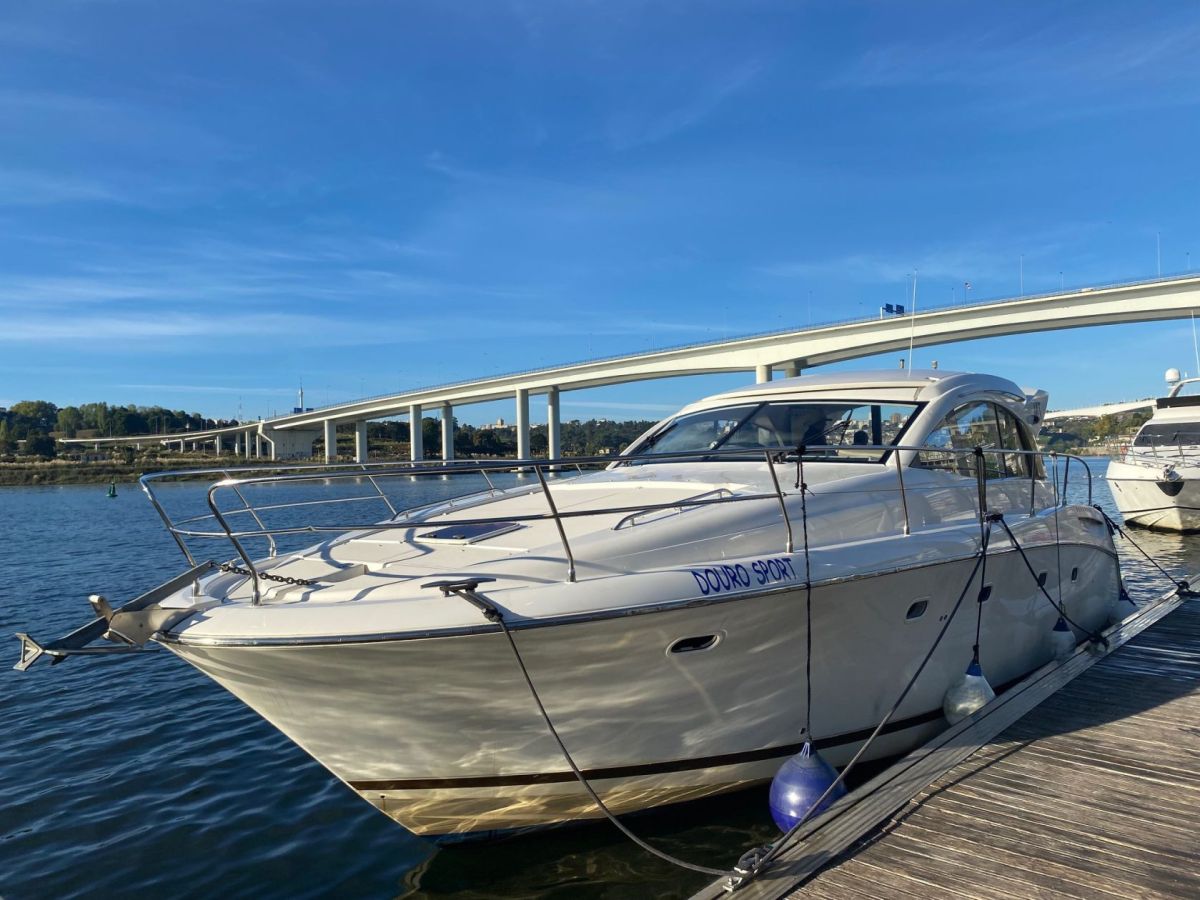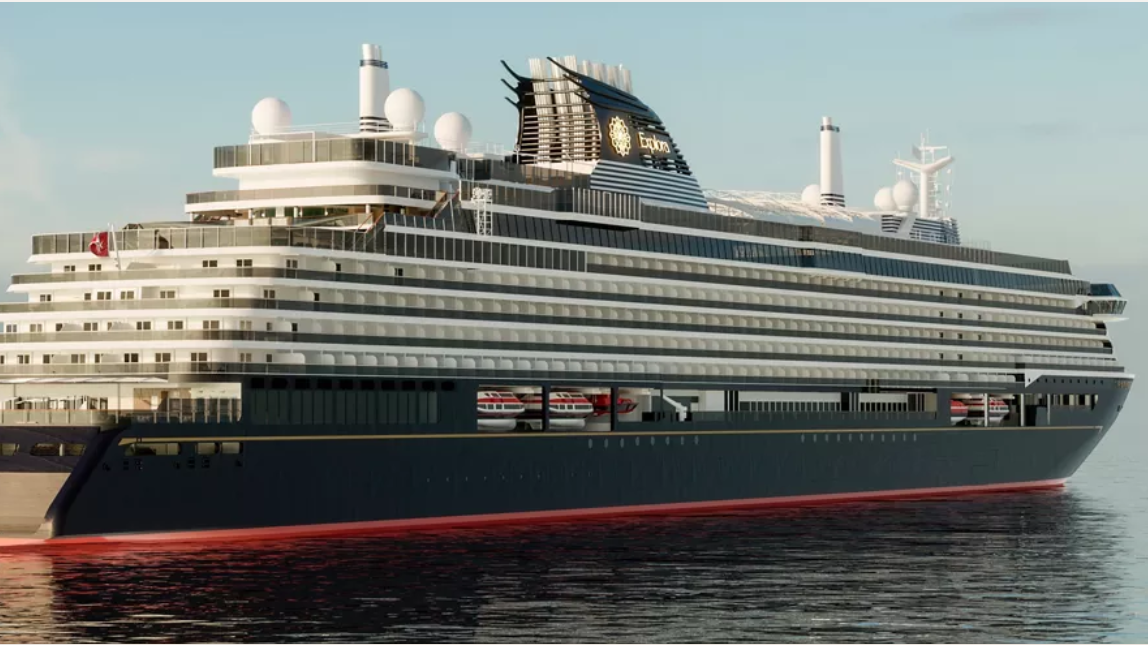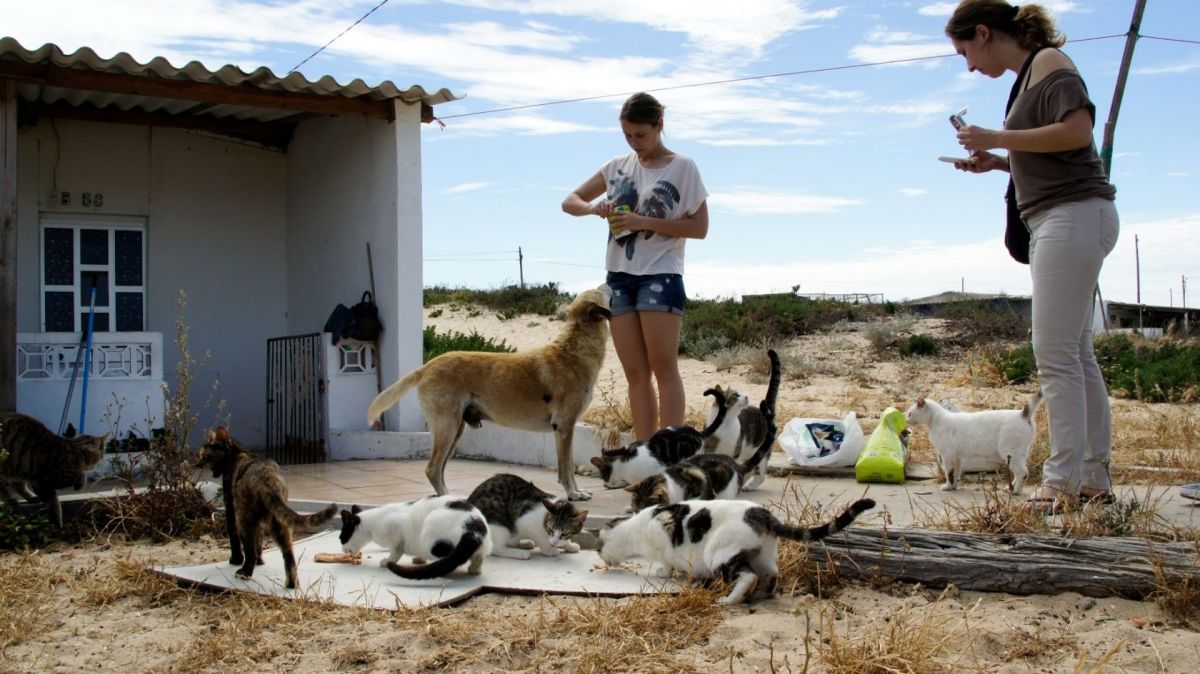We left my house at 7:00am sharp in order to be more than punctual for our planned departure at 9:00, and as we crossed the bridge that takes the A20 over the Douro River, we could see the Freixo Marina below, the starting point for our journey up the waters that have been pivotal to history, commerce, and culture throughout millennia on the Iberian Peninsula.
The Douro River, which begins in the Duruelo de La Sierra in Spain, and was personified as the god “Durius” by the Romans who dominated the region for 700 years, is the third longest river in the Iberian Peninsula. In Portugal, it flows through five districts as it divides them evenly between its north and south banks; Bragança, Guarda, Viseu, Vila Real, Aveiro, and finally Porto on the Atlantic coast. Our journey was to take us as far as Pinhāo in the heart of “Vinhateiro”, or Vine Land, where the Douro Valley, which has become synonymous with port wine around the world, offers the opportunity to get away from the bustling crowds of tourist-ridden Porto. However, it was the river itself that held our imagination as we pulled into the marina and found our boat.
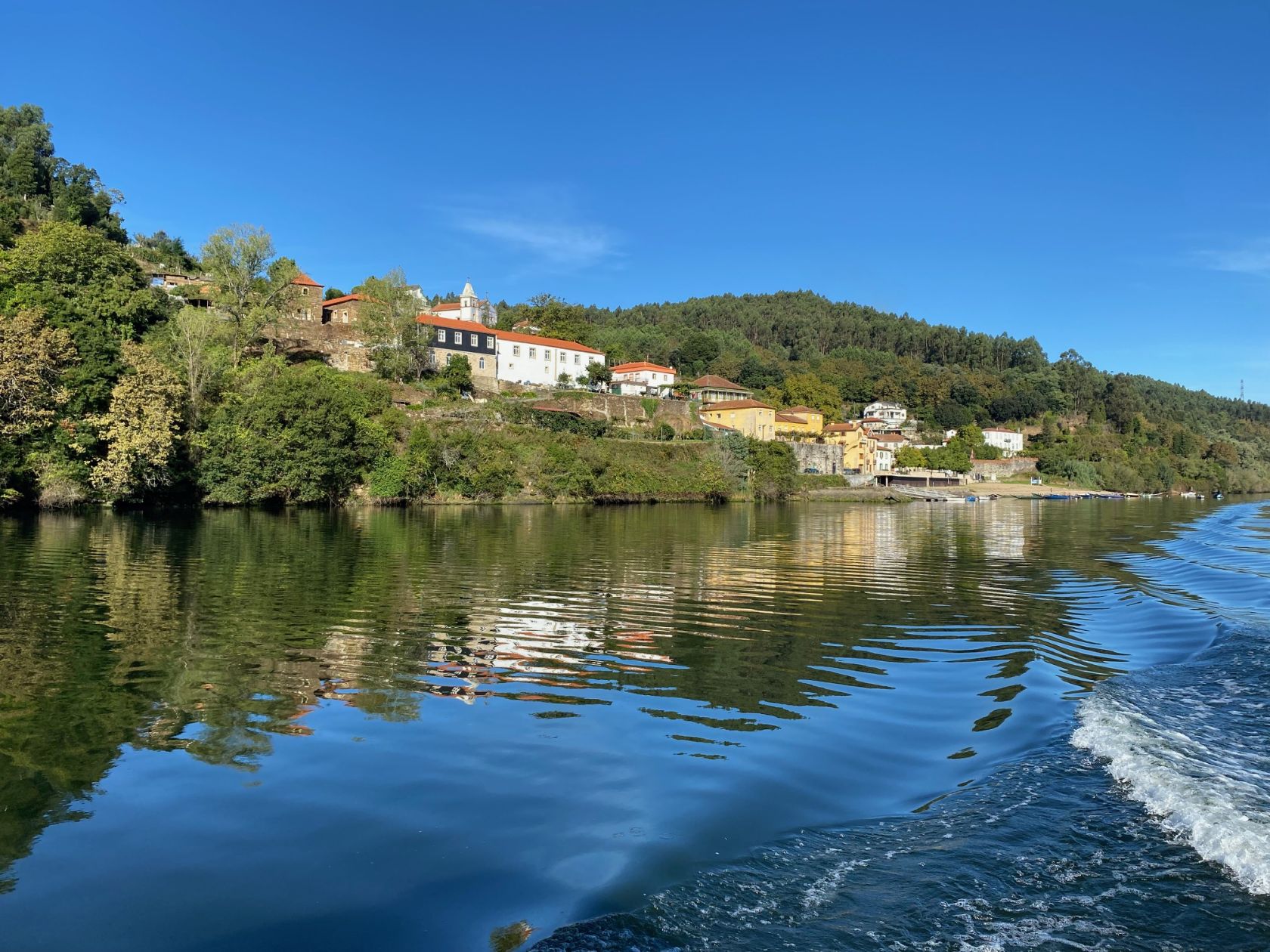
We really didn’t know what to expect when we arrived, but as we carried the few things we brought with us onto the boat, its impressive layout immediately gave us a giddy feeling of anticipation for our little voyage. Our home for the next three days and two nights would be this 42-foot Jeanneau Prestige cabin cruiser that, according to our captain, Tiago, was built in 2007 and boasted two 350 Volvo Penta engines. With lounging areas both aft and beside the helm, lower and forward berths beyond the kitchen and shower room, it would allow for plenty of space to walk about, recline at our leisure, and enjoy the nicely prepared noshes, gin and tonics, glasses of vinho verde wine, and anything else that would keep us cool and well-contented amid the late September heat on the Douro River.
Tiago was only 23 years old, but already an experienced skipper on the Douro since he was 17. A native of Porto, he knew its river and coastal waters extremely well and had plied the entire length of the Douro dozens of times before. His first mate and steward for our trip was Daniel, a Brazilian who had travelled the world as a gourmet chef, but was now learning the helmsman trade under the guidance of Tiago. It took me aback when he told us he was 40 years old. He didn’t look any older than our young captain.
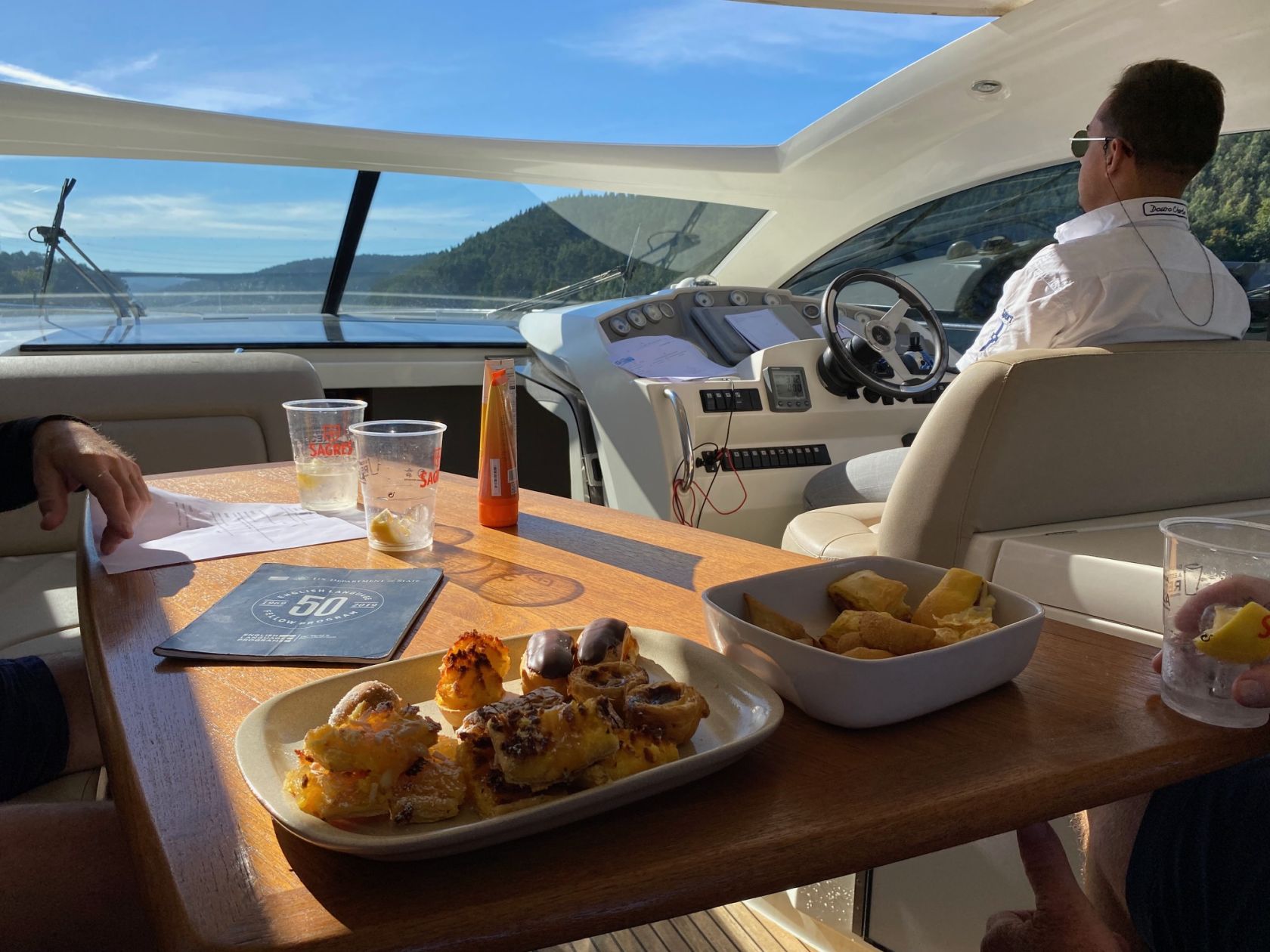
As we pulled away from the dock, Tiago maneuvered the boat into the middle of the channel, and the river opened itself up to us. It would be a hot and sunny day, but the mid-morning air still held a cool touch to it, like a welcoming gift.
Old friends
We are old friends, Paul, Terry, and myself; and by old, I mean it had been well over forty years ago when we worked together on a northern California beach for the National Park Service. We were young, strong, athletic. We felt immortal as young people do, and had little fear for whatever the Pacific Ocean could throw at us. Paul and I had been lifeguards, and Terry was a Park Ranger. While Terry stayed on and made a career with the Park Service, Paul and I made different lives in different ways. Paul became a very successful building contractor in Marin County, and I left the U.S. altogether to work and live in a variety of foreign countries over the years, bouncing around from one place to another until finally settling down in Portugal more than ten years ago.
It had been quite some time since I had seen them each at one time or another, and even longer since we found ourselves all together again in one place. Terry was divorced with two well-raised adult children successfully making their own lives. Paul was still married to the same woman he had fallen in love with decades ago, and together they had adopted two boys who were on their way to becoming responsible adults. And then there was me, who never bothered with getting married or having children, but stayed a vagabond until it was too late for either. Being such as it is , however, we left our pasts to rest on the dock this particular morning. They’d be there went we got back. We wanted the next few days solely for the here and now. At least one last time, we would saddle up and ride together again, albeit with arthritic pain and the uncertainty of where anyone left their eyeglasses a few moments before.

A light breeze stirred on the river as we moved past the municipality of Gundomar, a few miles east of Porto’s city center, where the crowded sidewalks and congested streets became less than an afterthought. Occasionally, fish broke the surface between us and the passing landscape, most likely Tainha, the most prevalent species of fish in the Douro, as Tiago told it. A Grey Heron glided along trees that lined the southern shore, its wings held still and parallel to the water’s surface, which provided a draft within a space of a couple of feet. “Here are your waters and your watering place. Drink and be whole again beyond confusion.”, as the final lines of Robert Frost’s poem Directive so aptly put it.
Dams
It was only a short while until we reached the first dam, the Crestuma-Lever, and its lock that we’d go into in order to be hoisted up to the river’s water level on the other side. The Crestuma-Lever is 11 meters high and would take about 15 minutes to pass through.
The dams of the Douro were built over time during the 1960s and ‘70s, and there are 15 of them altogether along the water’s journey to the Atlantic. The first five are in Spain, the second five straddle the Spanish/Portuguese border, and the last five belong to Portugal. The locks of each are spacious enough to accommodate boats up to 55 meters in length, according to Tiago. Passage for our 42-foot craft was €35, the toll depending on the size of the boat. The Crestuma-Lever was the first of three we’d pass through.
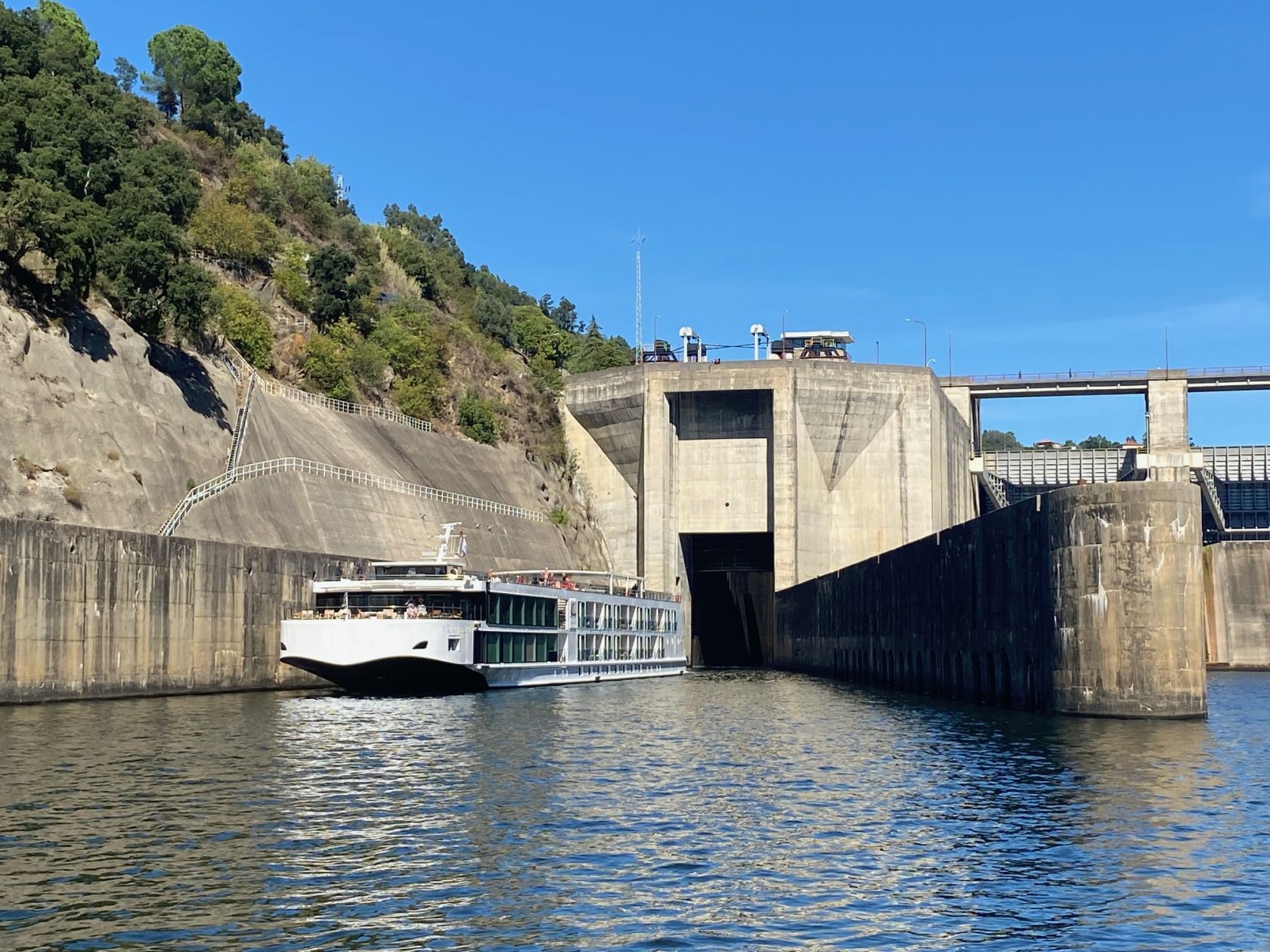
Daniel served up a plate of Portuguese pastries as the warmth of the morning sun began to be felt, and we took off any layer of clothing we’d been wearing when we first started out. Further on up the river at a fork where the Tâmega tributary flows into the Douro, we stopped for coffee at the Quinta de Santa António. While Terry and I got a strong dose of caffeine and enjoyed the view, Paul sauntered off, which he was often prone to do. Once back on the boat and underway again, Paul showed us photos of a cemetery he stumbled across. “Every single grave had fresh flowers!” I could see it was true. There must’ve been up to 200 or so graves altogether.
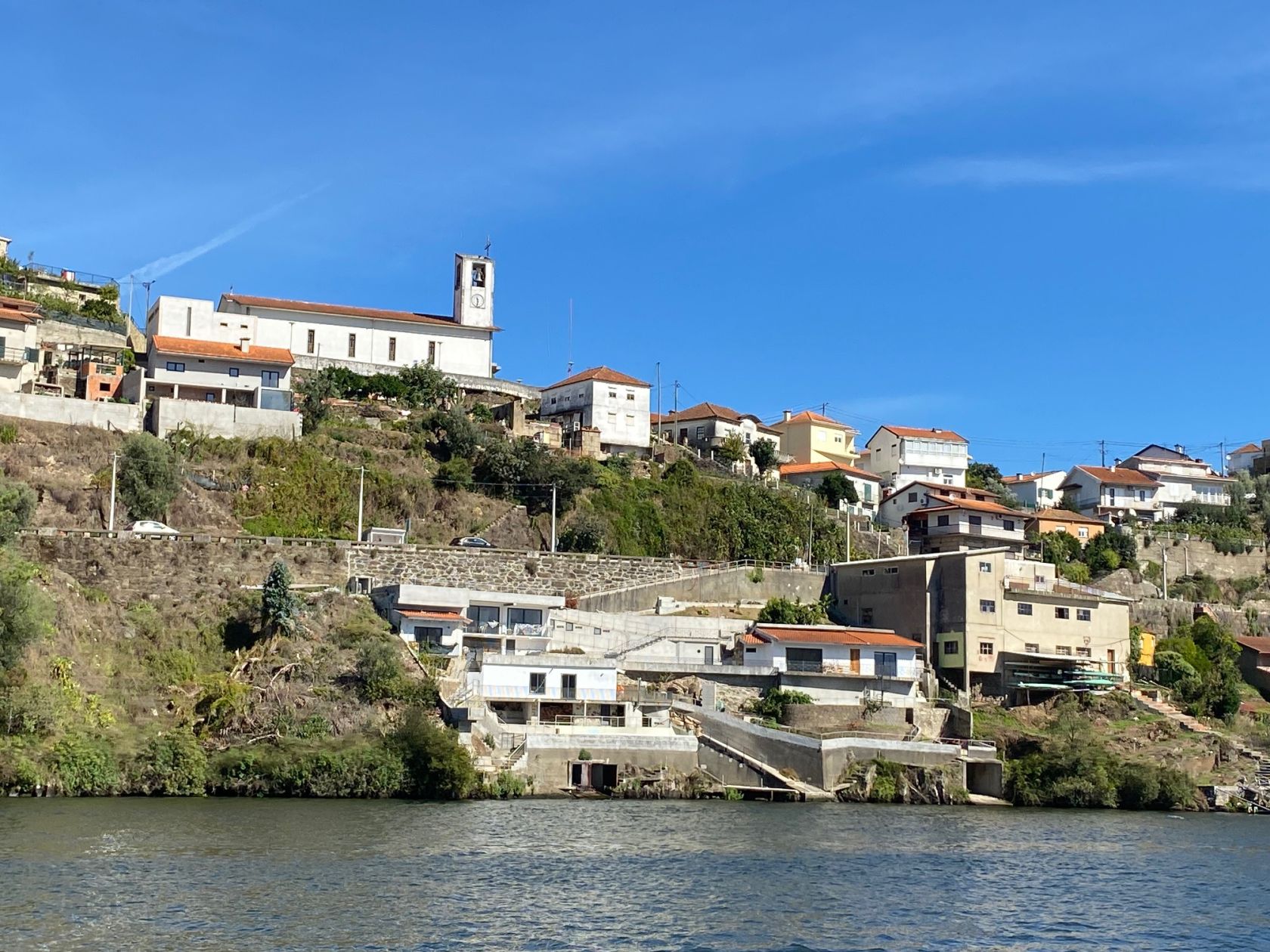
I’ve found the Portuguese quietly appreciate their lives in the smallest of ways, and those who are no longer here are still apparently appreciated as well, but the Portuguese aren’t without their superstitions, as just before the fork of the Tâmega tributary, a massive 12-meter high golden angel rises above the water on the south bank where two road bridges curiously cross the river side-by-side. The monument is a tribute to the victims of the Hintze Ribeiro Bridge when it collapsed in March of 2001 during massive flooding on the Douro. A bus and three cars plunged into the turbulent waters, killing 59 people. However, it was when the bridge was rebuilt that prompted the second bridge beside it to be built. Apparently, the Portuguese refused the use the newly replaced bridge as they overwhelmingly regarded it as cursed, so the authorities had little choice but to build another bridge a short few meters adjacent to the first one.
With the day’s heat in full swing, we stopped at a random spot for a swim in the river’s cool water, and by the time we reached the second dam, the Carrapetelo, it was 2:40 in the afternoon. This was the highest of the dams we’d be passing through. At 30 meters, it would take almost half an hour in the lock to get to the other side. We had to first wait for one of the massive hotel boats that was coming down the river to exit the lock. These boats, which can reach 55 meters in length, are common on the Douro and can hold up to 200 people who have their own rooms and are provided with entertainment, food, and drink during their voyage, like any of the larger, more recognizable, cruise ships that go from one open-sea port to another. As we exited the lock, we spotted a large Roman-built bridge, beautifully intact, that crossed a tributary on the northern side, still effectively connecting two hillsides after centuries.
Peso da Régua
It was around 4:00 p.m. when we reached the town of Peso da Régua, where the Douro River Valley can be seen for what it is best known for: its vast vineyards that cover the hillsides in terraced rows. It is here that the land for the best quality grape varieties which give the world port wine is coveted by the largest vintage producers, like the Symington Family Estates that owns four of the leading port houses: Graham’s, Dow’s, Warre’s, and Cockburn’s; Taylor’s, who is Graham’s largest competitor; Ferreira, Sandeman, Offley, the “Douro Boys”, among others. According to a report in 2020, there are about 19,633 vignerons, or grape farmers, in the Douro Valley, with 61% of those farmers owning less than 2.5 acres of vines that they look after on the weekends while keeping more gainful employment as their main income. Only 266 grape growers on the over 99,000 acres of vineyards in the Douro Valley own more than 50 acres of vines, and a number of these are consolidated under but a few port wine houses.
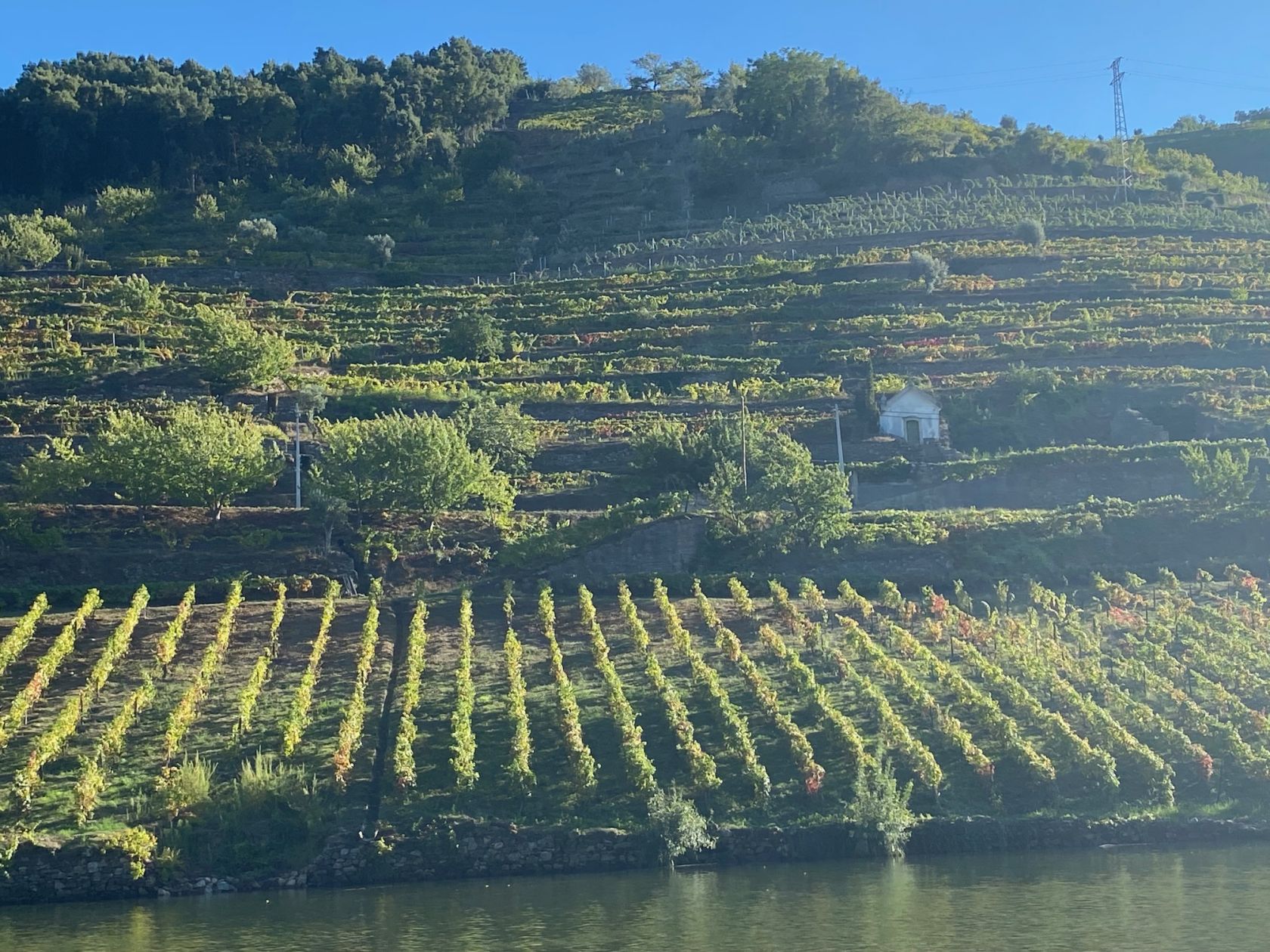
When the Douro River fully enters Portugal from Spain (after dividing their borders for 70 miles), major population centers are much less frequent and the scenery on either side takes on a rural landscape that could’ve been painted by Winslow Homer or Johannes Vermeer. Before we reached Peso da Régua, the small villages that we passed by were pastoral and lovely, but once we entered the region that has been designated as a UNESCO World Heritage Site for its viticultural legacy, the landscape soars dramatically up from the banks of the river to magnificent heights with lush, terraced hillsides of cultivated sophistication.
According to the Center for Research, Study and Advancement of Mountain Viticulture (CERVIM), the Douro has more than 37,000 acres of slopes steeper than 30 degrees, composing more than half of the world’s steepest mountain vineyard terrain. It was an even-handed view of both the north and south slopes from our position in the middle of the river’s channel as we took in the verdant beauty of it all.
We had traveled about 70 miles on the first day. A few hotel boats were docked near ours, and when the three of us sauntered into town, the sun had already set. Peso da Régua, or just Régua as it’s commonly called, appeared to be a quiet place, one might say almost dead. We wandered the dark streets aimlessly, trying to find a place that was open, but everything was empty as if the town had been abandoned not too long ago. We finally found a rather busy local restaurant a street or two up from the waterfront. The “O Maleiro” is a very nice and very cheap place to indulge in the regional cuisine. The tables were full of people from the hotel boats who had the same idea we had, and the one waiter who was handling it all never missed a step in his service or his genuinely pleasant personality. The night had a perfect temperature to it and everyone was clearly enjoying themselves with the excellent food, wine, and good company.
Night and day
The next morning, we decided to try out Régua again for some coffee and breakfast before casting off at 11:00. It was a completely different town in the daytime. The streets were busy, the shops were open, and people were going about their daily lives, walking on their way to work, or crawling along in traffic on the small avenues. It was clearly a town that operated on the time accorded to the local people who lived ther,e rather than specifically catering to the tourist trade that comes to stop at the riverside docks. Tourism for the people of Régua was definitely an added benefit for the town, but by all appearances was something more incidental than a mainstay. Whether or not tourists showed up, they had things to do.
After finding a nice, little “pastelaria” for coffee and something to eat, we discovered the Douro Museum, which is one of the very best museums I’ve ever had the pleasure to visit. Dedicated to promoting the active preservation of cultural artifacts within the Douro Region, its collection and purpose not only centers around fine art, but also focuses on ongoing efforts towards ecological, economic, and historical awareness initiatives that include restoration of old texts, historical and artistic study, documentary photographic surveying, and sustainable curative intervention for the region. At the time we visited, the museum was featuring an exhibit of Amanda Passos, a local artist who was born in 1944. Her work was startling and breathtaking, comparable to some of the greatest artists of her time.
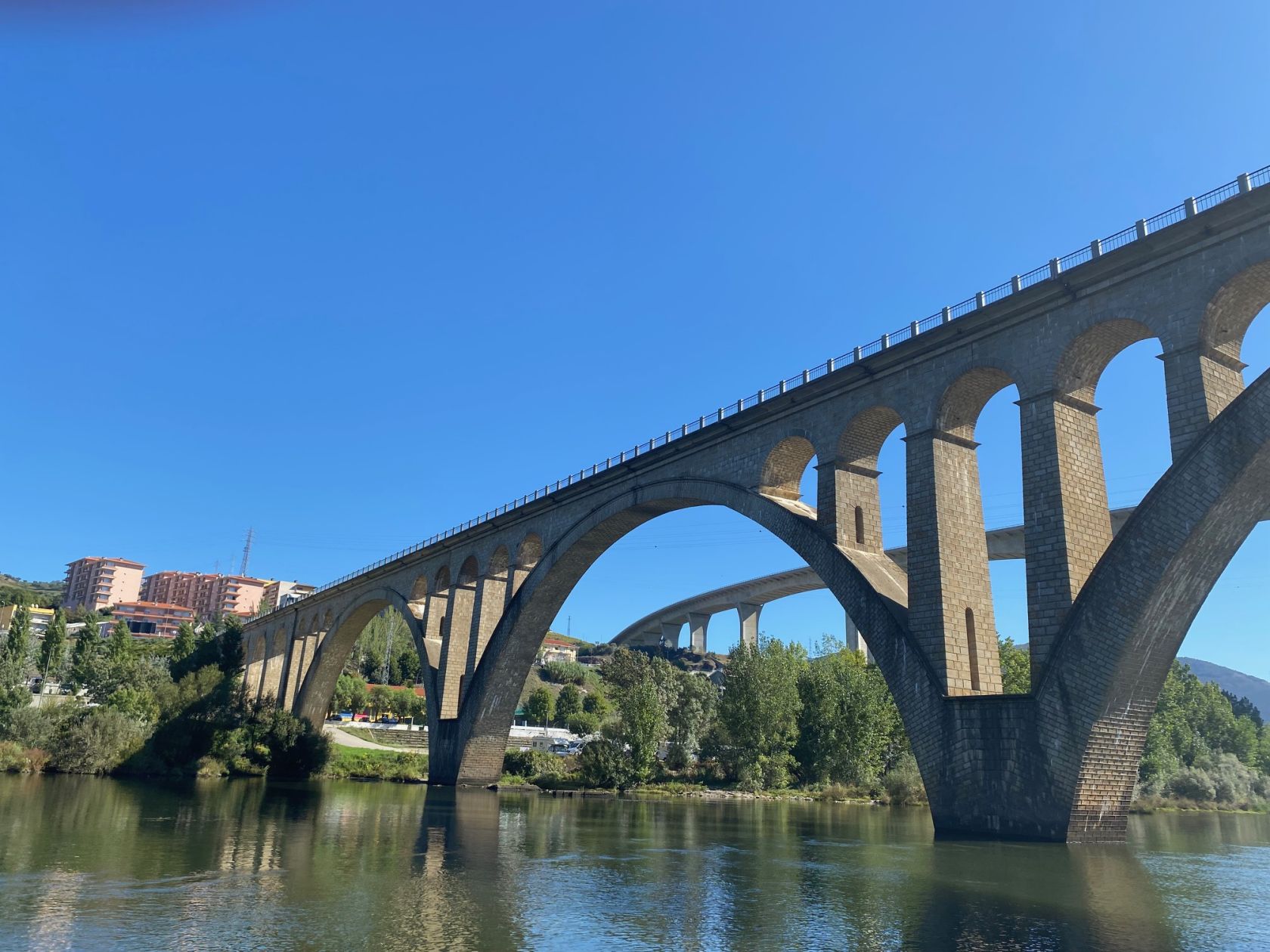
On our departure from Régua, the late morning sun was reflecting off the surface of the water as if reflecting off glass. It would be another clear day. We passed under the N2 roadway, renowned as the Portuguese Highway 66, that starts in Chaves on the Galician border, winding its way down the middle of the country to Faro in the Algarve. Not far up the river from Régua is the Régua dam, and the last we’d pass through before reaching our turnaround point in Pinhāo. While we waited for the green light to allow us to enter the lock, we could hear gunfire in the hills on the north side of the river. Most likely, locals hunt wild boar that are prevalent in Portugal. With the Régua dam twenty-two meters high, it took about twenty minutes to pass through.
Pinhāo
It didn’t take long for us to reach Pinhāo at about 2:30 in the afternoon. With a good part of the afternoon still ahead of us, we booked a wine tasting tour at one of the smaller vineyards, Real Companhia Velha, allegedly a family business founded in 1756 and still Portuguese. It wasn’t a far walk across the bridge to the other side of the river from where our boat was docked. The tour began with a lovely ride all the way to the top of the ridge, where rows upon rows of grape vines could be seen for miles on end. The now distant Douro River below wound its way around one turn, then another. We sampled the grapes off the vine, and they were like candy. Back at the wine-tasting house, we sized up their Ruby and Tawny ports, as good as any my inexperienced palate had tasted.
We walked into Pinhāo for dinner after sunset with the intention of finding a restaurant Paul had found on the internet called “The Bridge”. Pinhāo felt just as local as Régua, its streets a bit narrower and more labyrinth-like. The restaurant was a bit removed from the river, somewhat hidden away in town, but we managed to find the place situated next to an old Roman bridge, hence the name. With the wine-tasting tour still fresh in our minds, we order a bottle of port, then another, and another after that as we indulged our palates in the best local dishes we had had on the trip yet. By the time we stumbled out of the restaurant, our sense of direction was a bit impeded, but we forged ahead into the night, made a number of wrong turns, and eventually found the boat.
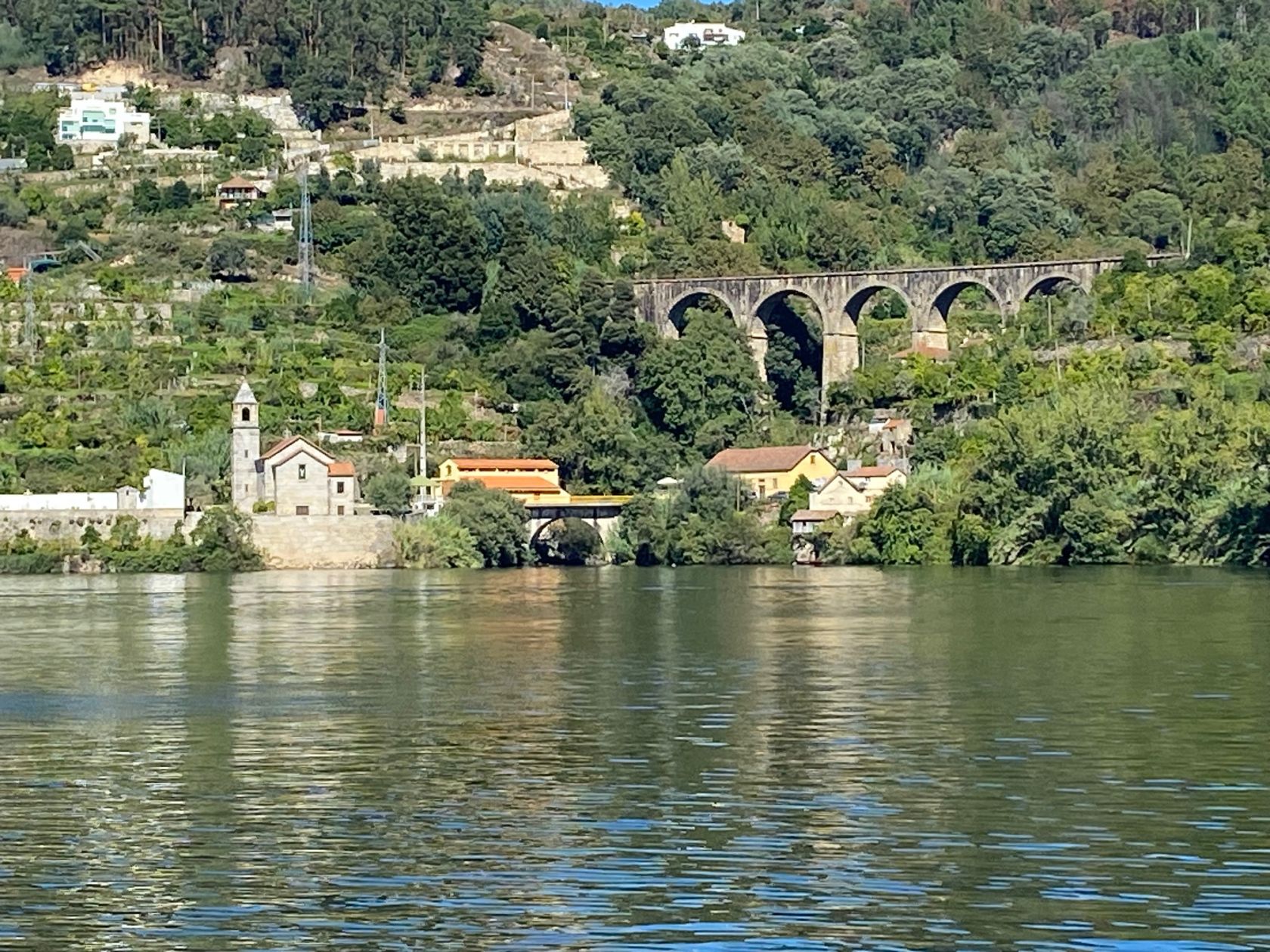
It was an early 8:00am departure the next morning, and the day arrived overcast and grey with a chill to it. It was time to head back the way we came. The sun was yet to rise over the high ridge from the southern bank and I stayed wrapped in my blanket on the stern deck where I had slept the past two nights, sipping the strong coffee Daniel had just handed me. Terry was having a hard time opening a jelly-spread package, and Paul gave him a hand. I quietly shook my head at how old we had gotten.
Last stop
By ten, the sun broke through the metal fabric of the sky, the water was glass, the day became warm, and the way back took on a familiar calm. It would be a slow, but steady pace all the way back to the marina, but one last stop on the way back allowed us a while to enjoy the riverside charm of Porto de Rei.
At a small family-run café just up a dirt road, two dogs on the patio regarded us with little more than uninterested stares. When we finished our coffees, Paul and Terry went in their own direction and I made my way up to a huge, palatial mansion that I had seen when we came in to dock. It was massive, majestic and opulent in its time, but now stood abandoned. I was astounded by its size, its incredible beauty, and its magnificent architecture. I could still feel the life it once had as I circumnavigated the property, many of the windows broken, but with grand curtains still draping the interiors. On the front façade, a coat of arms in stone stood the test of time. As I researched it later after our trip, I found it is known as the House of Porto Rei, or the Great House, built in the 16th Century by one Luís de Oliveira, and its ownership changed hands through the following centuries by a list of Portuguese families. It apparently has a chapel, several halls, rich ceilings made of chestnut wood, and a great kitchen with a huge chimney. Had I had the time, I would’ve been tempted to find a way in. From the information I found, part of the house on the west side is allegedly now owned by a Portuguese doctor whose name is as long as a short sentence, with several other people owning the adjacent farm land. I came back to the boat with ghosts in my head.
When we reached the marina late in the day, we said our goodbyes to Tiago and Daniel and thanked them profusely for their good service and company. The cup of three days and two nights on the Douro River had been filled to the brim before becoming too much for three very old friends. We had our lives on Terra Firma to get back to.
Rivers have been a mythic symbol for the passage of time ever since time gave everyone enough time to sit down and actually think about it, and the Douro lent itself to three old friends, who are only getting older, to once again put things on pause for a short while before those unknown waters of that vast, open sea come into view. The three of us went home in our own directions, thankful for the memories that such an opportunity had given us.
Article originally published with International Living Magazine.
Original article can be found here: https://magazine.internationalliving.com/internationalliving/library/item/february_2024/4166792/

